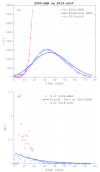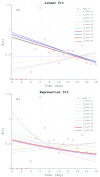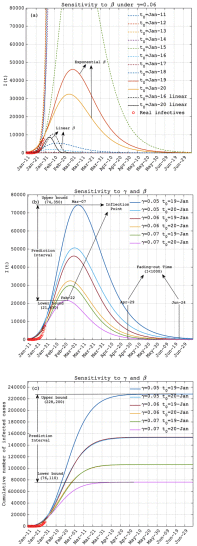Early Prediction of the 2019 Novel Coronavirus Outbreak in the Mainland China Based on Simple Mathematical Model
- PMID: 32391240
- PMCID: PMC7176026
- DOI: 10.1109/ACCESS.2020.2979599
Early Prediction of the 2019 Novel Coronavirus Outbreak in the Mainland China Based on Simple Mathematical Model
Abstract
The 2019 novel coronavirus (2019-nCoV) outbreak has been treated as a Public Health Emergency of International Concern by the World Health Organization. This work made an early prediction of the 2019-nCoV outbreak in China based on a simple mathematical model and limited epidemiological data. Combing characteristics of the historical epidemic, we found part of the released data is unreasonable. Through ruling out the unreasonable data, the model predictions exhibit that the number of the cumulative 2019-nCoV cases may reach 76,000 to 230,000, with a peak of the unrecovered infectives (22,000-74,000) occurring in late February to early March. After that, the infected cases will rapidly monotonically decrease until early May to late June, when the 2019-nCoV outbreak will fade out. Strong anti-epidemic measures may reduce the cumulative infected cases by 40%-49%. The improvement of medical care can also lead to about one-half transmission decrease and effectively shorten the duration of the 2019-nCoV.
Keywords: Epidemic transmission; infection rate; mathematical model; novel coronavirus; prediction; removal rate.
Figures



References
-
- (2020). Wuhan Municipal Health Commission Infection Data. [Online] Available:http://wjw.wuhan.gov.cn/front/web/list2nd/no/710
-
- Kwok K. O., Tang A., Wei V. W., Park W. H., Yeoh E. K., and Riley S., “Epidemic models of contact tracing: Systematic review of transmission studies of severe acute respiratory syndrome and middle east respiratory syndrome,” Comput. Struct. Biotechnol. J., vol. 17, pp. 186–194, Jan. 2019. - PMC - PubMed
-
- World Health Organization, WHO Statement on the second meeting of the International Health Regulations. (2005). Emergency Committee Regarding the Outbreak of Novel Coronavirus (2019-nCoV). Geneva, Swiss: Accessed: 2020. [Online] Available:https://www.who.int/news-room/detail/30-01-2020-statement-on-the-second-...
-
- (2020). World Health Organization, WHO Novel Coronavirus-Thailand (ex-China). Geneva, Swiss: Accessed: Jan. 14, 2020. [Online]. Available: http://www.who.int/csr/don/14-january-2020-novel-coronavirus-thailand/en/
-
- (2020). World Health Organization, WHO Novel Coronavirus-Japan (ex-China). Geneva, Swiss: Accessed: Jan. 17, 2020. [Online]. Available: http://www.who.int/csr/don/17-january-2020-novel-coronavirus-japan-ex-ch...
LinkOut - more resources
Full Text Sources
Other Literature Sources
